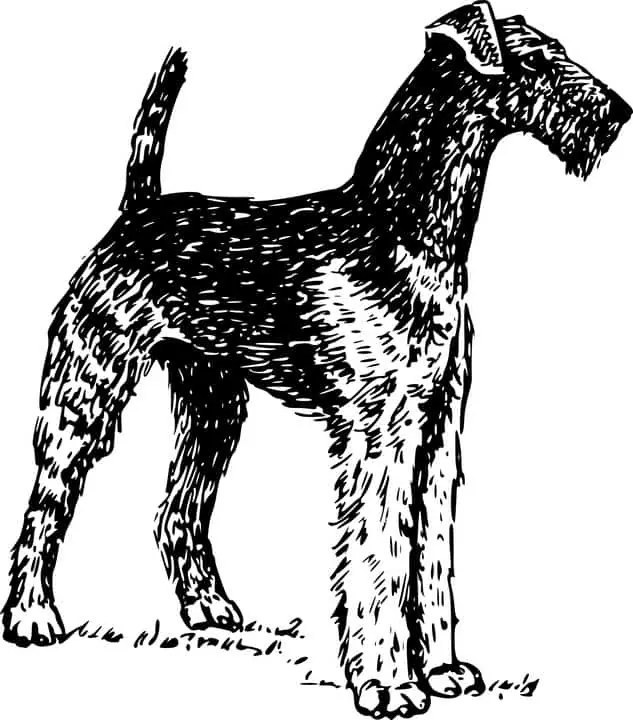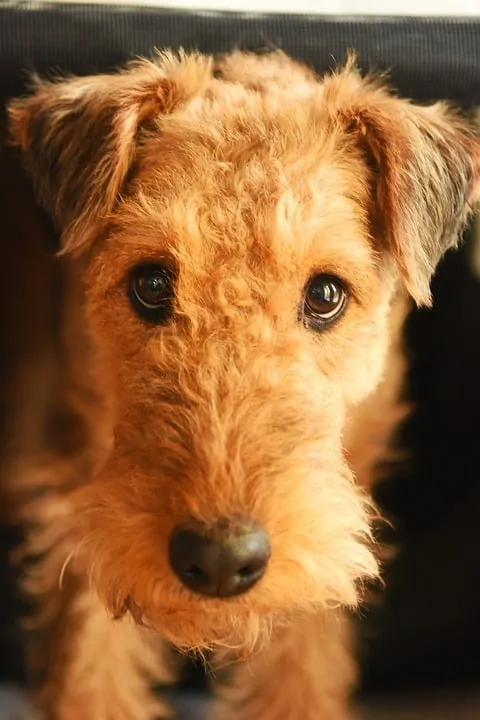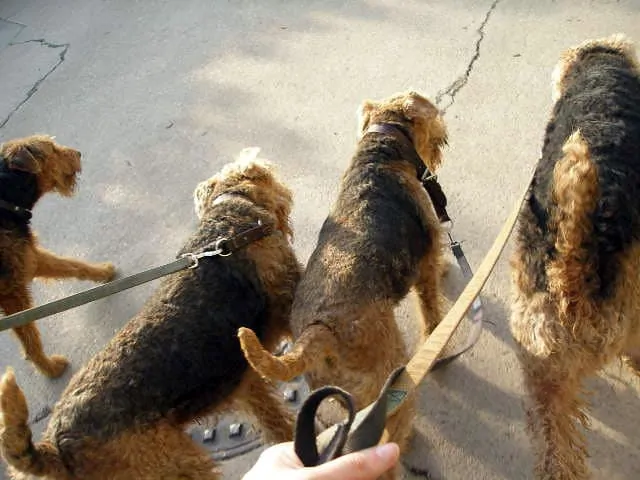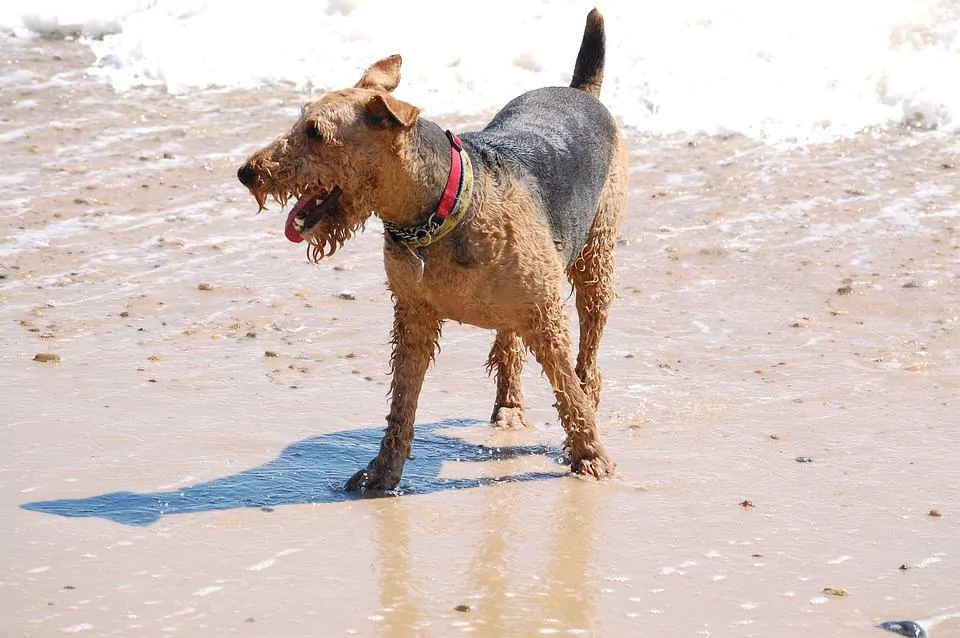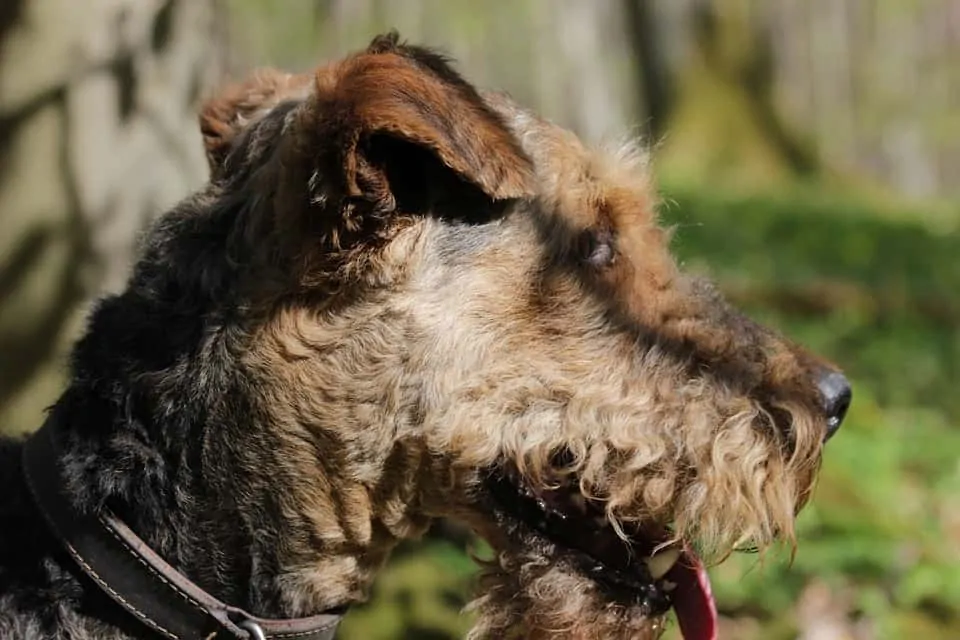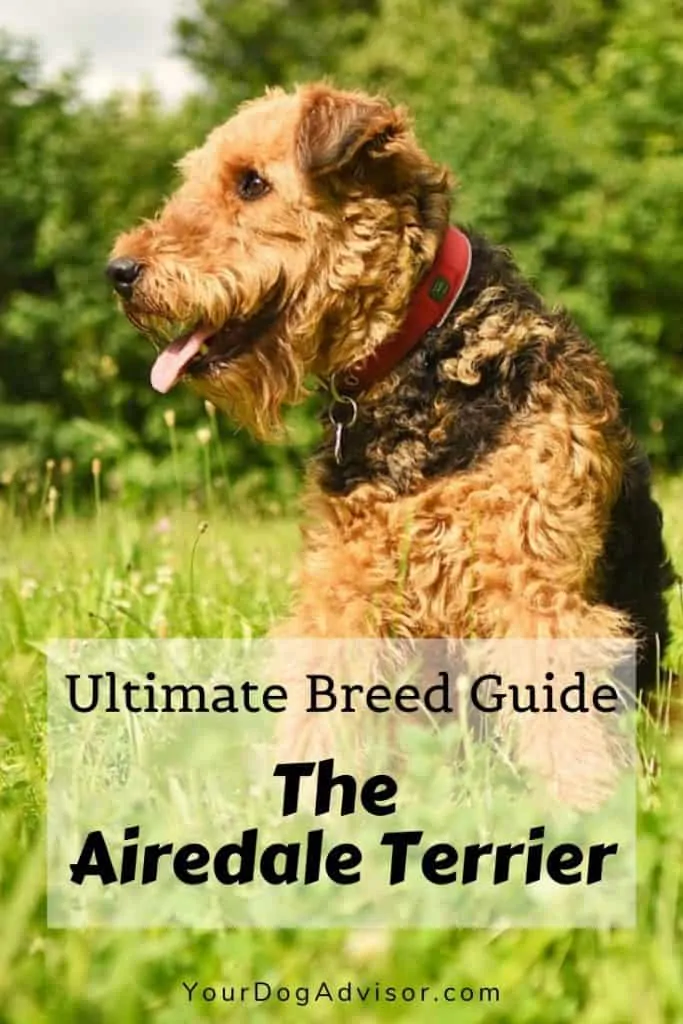As a utilitarian dog that is highly adaptable to a variety of lifestyles and jobs, the Airedale Terrier has rightfully earned its place as one of the most popular terrier breeds in the world. But, because this regal, intelligent, and courageous hound tends to be highly driven and very active, it is not the right choice for everyone.
Keep reading to find out if you have what it takes to live with the king of terriers.
Contents
General Characteristics of the Airedale Terrier
- Other names: Bingley Terrier, Waterside Terrier
- Height: 23 inches
- Weight: 50 to 70 pounds
- Lifespan: 11 to 14 years
- Origin: United Kingdom
- Colors: Tan with a black or grizzle saddle
- Activity level: Moderate to high
- Grooming needs: Moderate
- Best suited for: Active owners who can provide their dog a job to do
The Aire is a charming canine companion overflowing with intelligence, curiosity, and determination. With proper socialization and attention, they make great family dogs and are highly adaptable to all different types of lifestyles.
The History of the Airedale Terrier
The Aire Valley, or Aire Dale, in Yorkshire, became the birthplace of this modern-day terrier around the middle of the 19th century.
The area was home to a large population of mill and factory workers, many of whom took pride in breeding dogs who could compete in a wide range of sports from hunting competitions to dog fights. The most celebrated of these hounds were also capable herders, property guardians, and all-around family and utility dogs.
The terriers of the time were used to “go to ground” during hunts and flush game out of their burrows and attack them in the open fields or in the wetlands. While those in the higher classes usually kept scores of dogs–hounds to track prey, bird dogs to mark and flush fowl, and terriers to flush and kill varmints–the working class required a single dog that could do all of these tasks and more.
Over the course of the 19th century, English Black and Tan Terriers were crossed with Otterhounds, other terriers, and possibly even some bull baiting breeds to create a large, powerful, and intelligent dog. These first Airedales were capable of a wide range of tasks from tracking and flushing ducks to hunting large game.
The breed was revered for its versatility and for its courage and determination.
Like all terriers, the Airedale was independent of mind and capable of tracking and killing game without much input from their owner. Because of this and because of their size and athleticism, the dogs are often used by lowerclassmen to poach game on the estates of the upper class.
Early Airedales had a similar look to many of the English terrier breeds of the time but were much larger. This size made it harder for them to go after prey underground but allowed them to be used to chase down much larger game like fox and even mountain lion.
Stories of this incredibly useful dog soon gained the Aire popularity around the world, with the dog being recognized by the AKC in 1888 and the UKC in 1914.
But these courageous hounds didn’t truly grow in popularity until the First World War. Aires were utilized by the military as messenger dogs on the battlefield and by the Red Cross as a means to search out survivors.
Tales of their bravery and abilities catapulted them into the top spot of the most popular breeds in the US by the 1920s. Meanwhile, their popularity in Europe and Russia increased as the dogs became increasingly popular for use as police dogs, military dogs, and service canines.
Today’s Aires are still as talented as their forefathers, but spend much less of their time hunting and herding, and much more of it excelling at doggy sports and babysitting their human siblings.
The Temperament of the Airedale Terrier
Like all terriers, the Airedale is a highly driven and focused dog who needs a job to occupy his intelligent mind. Without proper stimulation and guidance, these extra-large terriers are likely to get themselves into trouble.
All that drive correlates with a higher than average need for activity and exercise. These agile dogs make great jogging, hiking, and exploring companions.
While they were bred largely for their utilitarian abilities, these dogs are also quite famous for being loyal, loving, and, often, quite clownish. They enjoy being with their families almost as much as they enjoy getting a job done.
But physical exercise will never be enough to dull this breed’s instinct to chase, problem solve, and engage in those wide-ranging jobs they were bred for.
Luckily, because these dogs are so versatile, you have almost an unlimited number of choices when it comes to finding them a job to do. Aires excel at trick and obedience training, agility, flyball, scent work, barn hunts, search and rescue, herding, tracking, and can even be trained as gun dogs.
Despite their hot-blooded nature, these dogs also make surprisingly capable family companions. Their energy and larger size can make them a little much for very young children and babies, but they are naturally gentle and loyal to their family group.
With strangers, Aires show no fear but aren’t typically aggressive. This is especially true of dogs that were well socialized as puppies. They make great watchdogs and will alert to trespassers while readily running up to unknown visitors.
Their bravery knows almost no bounds, and because of this, these dogs are known to get themselves into situations that can easily get them hurt. Unfortunately, they are also known for having a low pain tolerance and determination that outweighs their drive for self-preservation. It is not uncommon for Aire owners to overlook injures until they become infected or more serious simply because their dog failed to show signs of being in pain.
>>>Learn how to create your own dog first aid kit.
Overall, the Aire is a smart pup that requires plenty of mental and physical exercise. They need a job to do but are likely to eagerly accept any work you hand them whether that be keeping the barn free of rats or babysitting the kids as they play in the yard.
<iframe width=”560″ height=”315″ src=”https://www.youtube.com/embed/1yWd6_gF5OQ” frameborder=”0″ allow=”accelerometer; autoplay; encrypted-media; gyroscope; picture-in-picture” allowfullscreen></iframe>
Learn more about the Airedale in this episode of Dogs101.
Health Issues Common to the Airedale Terrier Breed
In general, the Aire is a healthy dog with ailments similar to other breeds in their weight class.
Here are some of the more common health issues you may see in your Airedale.
- Ear infections
- Skin infections
- Allergies
- Thyroid issues
- Bloat
- Hip dysplasia
- Cancer
The Aire is a hardy breed that is rarely likely to complain about pain or other irritations. But, like many terriers, they do commonly suffer from skin issues including dermatitis.
Some instances of itchy and inflamed skin in terrier breeds can be traced back to their coarse coat. Dogs with this type of coat don’t typically shed the way softer coated dogs do. As their hair dies it tends to stay attached to the hair follicle rather than releasing and falling to the ground.
It is thought that this process of hair retention lends itself to skin irritation and pruritus. One way you can help prevent your dog from having to deal with this uncomfortable condition is by having them professionally stripped rather than simply cutting their hair when it gets too long.
In addition to food allergies, many Airedales suffer from seasonal and topical allergies. In fact, these types of allergies tend to be more common than food allergies and can be more difficult to treat without resorting to medications.
When clippers are used to cut back an Aire’s coat, the dead hairs are left in place. But stripping–a method of grooming used specifically on coarse coated breeds–removes these dead hairs using a serrated knife that catches on them and yanks them free.
While having your dog’s coat stripped instead and merely clipped is likely to help prevent some skin irritation, it may not be enough. Many Aires suffer from food and environmental allergies. If your Airedale has especially red skin or tends to lick themselves obsessively, pay special attention to what you are feeding them. An elimination diet may be necessary to rule out food allergies and sensitivities that can cause dermatitis.
Beyond feeding a diet free from allergens and irritants, feeding a quality high-protein, high-fat diet can also help keep your Aires skin in optimal condition and health.
Do Airedale Terriers Do Well With Children and Other Pets?
Despite being highly driven and effective hunters, most Airedales make remarkably good family dogs. Because they are incredibly tolerant of pain and gentle with humans by nature, they tend to get along well with children, especially those old enough to play with.
Younger toddlers and babies may be too small to cope with the rambunctious nature of this powerful dog so any interactions should be closely monitored.
Like many hunting breeds, Aires are used to working in packs with other dogs. For this reason, they are generally sociable with other canines. Still, it is always important to socialize your pup early on so they can grow into a happy and confident adult. “Airedales!” by Lulu Hoeller / CC BY 2.0
Socializing your Aire puppy with young children when they themselves are still growing up is a great way to help guarantee they are tolerant of young humans as adults.
While Aires are known to be somewhat territorial, they do tend to do well with other dogs, especially if they are allowed to meet on neutral ground. The dog park, doggy daycare, and doggy playdates are all great ways to tire out a sociable Aire.
Just as with children, make sure to socialize your pup early and often with dogs of all shapes and sizes so they will be more excepting of dogs as adults.
While caution should be taken with all terriers around other furry family members, Aires tend to do better with cats and smaller animals than most. To help facilitate a peaceful household, again, it is important to introduce Aires to other furry family members while they are young so they learn to love their siblings of a different species rather than chase and hunt them.
What to Consider Before Bringing Home an Airedale Terrier
Think this versatile king of the terriers is a good match for you? Here are a few more things to consider before bringing one home.
Because they were originally bred to hunt river rats in the Aire Valley, these dogs are great swimmers and tend to enjoy spending time in the water, which makes swimming a great way to wear them out.
Activity Level
Young and adolescent Aires are especially active and need a lot of exercise and mental stimulation. Expect to have to spend at least an hour a day walking or playing with your Aire. They do tend to slow down in adulthood, but they are late bloomers, so that won’t come until around the age of three or four.
Mental activities are equally important. Plan to enroll your pup in obedience classes right off the bat and then in agility or another high octane doggy sport once they are physically mature.
Trainability
Aires are highly intelligent and built to please. That’s why they are so good at picking up random jobs and tasks. But, this intelligence can also lead to them getting bored easily, so keep training sessions short and exciting. Once your dog has mastered a skill, move on to something new. Incorporating trick training into your obedience training schedule can also help keep things exciting.
>>>Here are the best puzzle toys for your intelligent dog.
Some of these Aires are more independent and stubborn than others. The most important factors in training these dogs are to stay consistent and to train to your dog’s strengths and interests.
The Aire is a highly driven dog with a lot of ingrained instinct. But their intelligence and adaptability have made them a fixture in homes and jobs all around the world.
Grooming
The Aire coat doesn’t require much day-to-day work to maintain. It was bred to be low maintenance. These dogs tend to be better tolerated by individuals who are allergic to dogs because they don’t shed. They do require quarterly or bi-yearly grooming however, to keep their coats from getting too long and frizzy. Look for a groomer who knows how to hand strip rather than one that just clips to keep your dog’s coat and skin in prime condition.
Nutrition
Aires tend to be easy keepers and will do well on any quality home-prepared raw or commercial diet. If your Aire struggles with skin issues like many terriers, look for a diet that is free from common allergens and low-quality fillers and high in protein and fat from quality animal sources. These dogs are active and need a lot of calories, but they can still overindulge if you let them. To avoid joint and hip problems, keep a close eye on your dog’s weight and adjust their portions as needed.
Cost
The average purebred Airedale will cost you around $700, but quality show lines can go for as much as $7,000.
Overall, this is a healthy, medium-sized breed that won’t cost more than the average dog to own, but you may want to budget for doggy activities like rally and scent trials to help keep them occupied and happy.
Many Aire pups have dark markings on their face when they are young but grow into a more traditional tan face as they get their adult coat. “Gus-04” Derek Key / CC BY 2.0
10 Fun Facts About the Airedale Terrier
- Presidents Theodore Roosevelt, Coolidge, and Harding all owner Airedales.
- Oorang Airedales are a line of Aires bred to be larger and more powerful than the breed standard and have been around since the 1930s.
- An Aire named Jack supposedly ran through heavy enemy fire during WWI to successfully deliver a message despite a broken jaw and leg. He is said to have died immediately after reaching his destination.
- There were two Airedales on the Titanic when it sunk; Both were lost at sea.
- Famous author, John Steinbeck, owned an Airedale.
- Before German Shepherds became the breed of choice, Aires were frequently used by police forces in Brittan and Germany.
- The natural Aire tail is slightly stubby and usually curves over the back in a high arch. In America, the tail is often docked at about mid-length.
- Solid colored Aires, usually tan or black, are known to exist but are not considered purebred by the AKC.
- These dogs can be trained to herd, but their terrier nature means they can become too intense with livestock without proper coaching.
- Because they are the largest of the terrier group, Aires are referred to as the “king of terriers.”
Before You Go
Not sure you have what it takes to entertain this high-drive canine? Here are a few more breeds worth considering.

Sara Seitz has spent most of her life in the pet industry and has a bachelors in animal behavior from Colorado State University. Sara started working with dogs and cats as a high schooler at a rural boarding kennel. There she learned a lot about the bad and the ugly of the pet service industry. But not even the toughest day at that job would dissuade Sara from following her dream of working with animals.
In college, Sara got a job at a dog daycare and boarding facility in Fort Collins, Colorado. Her new career provided even more opportunities for learning about dog behavior than her classes did. As general manager of the daycare, Sara helped the company launch a new in-home pet sitting branch and trained to become a certified dog trainer. Between shifts taking care of peoples pets in-home and supervising dogs during playtime at the daycare, Sara organized and taught obedience classes.
Sara has always been passionate about bettering the lives of our canine companions. She soon found that advocating for and educating owners in the power of positive reinforcement training was one of the best ways to help dogs and their owners live happier lives.

